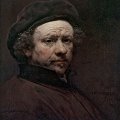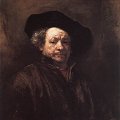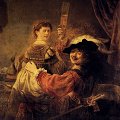Rembrandt Self-Portraits
 Very few artists of the modern
period have left as many self-portraits as Rembrandt van Rijn. His
lifelong study of his own physiognomy, his desire to keep a pictorial
record of his constantly changing physical and psychological features,
can be taken as a sign of his interest in autobiography and as proof
of the belief he nurtured, in spite of the many crises and setbacks he
suffered, in the uniqueness of the individual.
Very few artists of the modern
period have left as many self-portraits as Rembrandt van Rijn. His
lifelong study of his own physiognomy, his desire to keep a pictorial
record of his constantly changing physical and psychological features,
can be taken as a sign of his interest in autobiography and as proof
of the belief he nurtured, in spite of the many crises and setbacks he
suffered, in the uniqueness of the individual.
Different kinds of autobiographical narrative - memoirs, for instance, or episodes from lived experience interspersed in fictional texts (as with Grimmelshausen), or regular diary entries - were becoming increasingly important in seventeenth-century literature. "Affective individualism" (Lawrence Stone), which had begun to penetrate every aspect of bourgeois experience, had entered poetry, too. Petrarch had anticipated this centuries before with the interest he provoked in his biography: "You will wish to know what kind of person I was."
In the seventeenth century, this humanist motto was generally seen in a confessional or religious light. Rembrandt is known to have maintained frequent contact with members of many different confessions, religious groupings and sects (Jews, Mennonites, Socinians etc.), and it is probably not far wrong to assume that qualities which all these groups had in common - their ethical awareness, their intensely emotional character, and even their potentially oppositional nature - had a profound influence on Rembrandt's character.
On the other hand, it would be quite wrong to see Rembrandt's self-portraiture entirely in the light of his religious introspection. Indeed, his method reveals somewhat more affinity to doctrines of emotional expression which influenced contemporary academic art theory. In his early self-portraits, and in a number of smaller etchings which, significantly enough, are almost entirely devoid of ornament, allowing the artist to concentrate exclusively on the face, Rembrandt experiments with constantly changing facial expressions, working his way through the full gamut of human feelings and their physiognomic equivalents until, at one end of the scale, all that remains is a grimace. The face, the focal point of the personality, is given symbolic status: it represents human feeling.
Rembrandt thus acts out and gives visual form to different emotional states: alarm, worry, care, the torment of fear; or he portrays himself as someone staring with desperate, distracted eyes, with his hair standing on end (1630), or as a person laughing and showing his teeth. While Charles Le Brun (1619-1690), the Director of the Academie Royale founded in 1648, reduced the various forms of emotional expression to a schematic code in his posthumously (1698) published tract "Methode pour apprendre a dessiner des passions, proposee dans une conference sur l'expression generale et particuliere" (Method of learning how to draw the passions, proposed during a lecture on expression in general and particular), Rembrandt plumbed the depths of human emotion and discovered, by practical experiment, the means of its visual representation.
Rembrandt was not, therefore, giving vent to his own feelings. He was not interested in revealing his "innermost being", but rather in exploiting his own mimic abilities to produce an encyclopaedia of the human feelings. He fashioned an instrument of empirical psychology out of his theatrical, indeed comic, ability to slip into and simultaneously observe a wide range of emotional states: an example of the valuable contribution made by the fine arts to the development of a modern science whose subject was the study of different forms of human individuality.
 While the examples of his work
mentioned above, especially those of the early period, presented a
range of physical reflexes or expressive reactions to emotional
states, his portraits of the middle period go beyond spontaneous
physical expressiveness to experiment with a number of conventional
poses and gestures. The pose in his self-portrait of 1640, imitates
Titian's so-called "Ariosto" portrait, with the sitter's sidelong
glance and his bent arm resting on a parapet. Another self-portrait,
executed in 1659, now in the Mellon Collection at the National
Gallery, Washington, imitates the type of pose established by
Raphael's portrait of Castiglione. Rembrandt purports here to paint
himself as a "gentiluomo" (nobleman, gentleman), or "cortegiano"
(courtier).
While the examples of his work
mentioned above, especially those of the early period, presented a
range of physical reflexes or expressive reactions to emotional
states, his portraits of the middle period go beyond spontaneous
physical expressiveness to experiment with a number of conventional
poses and gestures. The pose in his self-portrait of 1640, imitates
Titian's so-called "Ariosto" portrait, with the sitter's sidelong
glance and his bent arm resting on a parapet. Another self-portrait,
executed in 1659, now in the Mellon Collection at the National
Gallery, Washington, imitates the type of pose established by
Raphael's portrait of Castiglione. Rembrandt purports here to paint
himself as a "gentiluomo" (nobleman, gentleman), or "cortegiano"
(courtier).
A third form of self-expression explored by Rembrandt is the use of ornamental devices, attributes and costumes to define status and present a calculated, or desirable, image of the self. Thus Rembrandt leaps from one role to another, constantly altering his social position. Sometimes, he appears as a beggar with outstretched hand, sitting on a rock (1630); there is perhaps good reason, too, for a number of his self-portraits to turn up surrounded by sketched scenes of beggars. At other times, we find him posing as a sophisticated gentleman with reinforced collar, chain of honour, precious stones or other attributes of rank; on one occasion, he paints himself as a prince with a scimitar (1634, etching. In the same year, interestingly enough, he portrays himself as a burgher wearing a beret). Yet another guise is that of the oriental sultan in a turban, executed in full-length; in this painting, the histrionic artificiality of the scene is underlined by the presence of an alternative costume in the shape of Roman helmets lying on a table behind him (1631, and c. 1631).
It would, of course, be possible to interpret the enormous variety of roles and poses in Rembrandt's self-portraiture psychologically, seeing them as examples of megalomaniacal wishful thinking, or as the sign of a frustrated social climber, or as a form of imaginative compensation for the suffering he experienced during various critical periods of his life. Some of this may well be true. Beyond mere wish-fulfilment, however, the majority of the approximately ninety self-portraits show Rembrandt mentally reflecting on social structures whose new permeability, flexibility and dynamism were the result of the bourgeois revolution in the Netherlands.
In his final self-portrait, executed in 1669 (Cologne), Rembrandt appears stricken by age, stooping, in a state of melancholic mirth. This reverts to the subject of his early physiognomic studies; and yet here, for the first time, Rembrandt's imagined role appears consistent with his real mood. Appearances are deceptive here too, however; it would hardlv be permissible to assume the painting represented a proclamation of Rembrandt's true state of mind. For once again, Rembrandt presents us with a visual puzzle, disclosing no more than he conceals.
On the left of the self-portrait there is the blurred shape of a face, probably the likeness of an old woman. The patches of light on the shaft and pommel of the mahlstick denote a studio setting.
 Considering the large
number of portraits he executed of himself in different roles, very
few show Rembrandt at work, or even suggest the nature of his
profession. Apart from two self-portraits executed in 1636 and 1648,
one of which shows him from the side, drawing (with Saskia in the
background), while the other shows a frontal view of him alone,
engaged in the same activity, but standing near a window in a dark
room, only two paintings from his later period refer to his work as an
artist (1660 and 1667/68). But here, too, the artist concentrates on
rendering the face, while his painting utensils are only vaguely
suggested. In one of the paintings, in which Rembrandt shows himself
actually working at the canvas, his utensils are just visible in the
darkness of the setting; in the other, where he seems poised between
two bouts of work, his brush and palette have been rendered immaterial
to the point of transparency by repeatedly scraping them with the
brush and rubbing in left-over paint, while the face, marked by age,
is trenchantly modelled in pastose layers of strong colour. The
self-portrait in the Frick Collection, showing him sitting
majestically on his throne, was probably conceived as a "portrait
histone" (portrait showing the sitter in significant historic
costume). Here, too, Rembrandt appears to have adopted a role: the
ruler casually holding up a sceptre in his left hand, which is resting
on the armrest of his throne. However, since the sceptre can hardly be
distinguished from a mahlstick, the impression that we are looking at
a self-portrait showing Rembrandt as a painter is probably
justified.
Considering the large
number of portraits he executed of himself in different roles, very
few show Rembrandt at work, or even suggest the nature of his
profession. Apart from two self-portraits executed in 1636 and 1648,
one of which shows him from the side, drawing (with Saskia in the
background), while the other shows a frontal view of him alone,
engaged in the same activity, but standing near a window in a dark
room, only two paintings from his later period refer to his work as an
artist (1660 and 1667/68). But here, too, the artist concentrates on
rendering the face, while his painting utensils are only vaguely
suggested. In one of the paintings, in which Rembrandt shows himself
actually working at the canvas, his utensils are just visible in the
darkness of the setting; in the other, where he seems poised between
two bouts of work, his brush and palette have been rendered immaterial
to the point of transparency by repeatedly scraping them with the
brush and rubbing in left-over paint, while the face, marked by age,
is trenchantly modelled in pastose layers of strong colour. The
self-portrait in the Frick Collection, showing him sitting
majestically on his throne, was probably conceived as a "portrait
histone" (portrait showing the sitter in significant historic
costume). Here, too, Rembrandt appears to have adopted a role: the
ruler casually holding up a sceptre in his left hand, which is resting
on the armrest of his throne. However, since the sceptre can hardly be
distinguished from a mahlstick, the impression that we are looking at
a self-portrait showing Rembrandt as a painter is probably
justified.
Unlike Aert dc Gelder, who treated the Zeuxis subject (1685) as a full historical canvas, Rembrandt's self-portrait (at Cologne), by keeping direct allusion to the story itself to a minimum, places emphasis on the representation of the face. The un-reflected and disrespectful satirical treatment of deformity has vanished under Rembrandt's treatment; what remains is a vulnerable depiction of the ugliness age has brought to his own features. Rembrandt's laughter does not poke fun at anybody, not even at himself. Too exhausted even to defy his own frailty, it is an expression of the stoic equanimity with which he resigned himself to approaching death.
Self Portrait (1630)
 Get
Get  a high-quality picture of
Self Portrait for your computer or notebook. ‣
Raising his head, the young man turns it briefly to one side. His
tangled, flying hair falls over his brow and the nape of his neck. His
soft lips are slightly opened, his eyebrows raised. The movement that
he makes brings his face into the ray of light falling over his left
shoulder. For a moment, his cheek and the tip of his nose are lit up
above his white collar. The shaded eyes meet those of the observer,
without fixing themselves upon them, as if they had become aware of
something, as if they were searching for something. The open
countenance appears lost in thought, given up to the world around it.
The very small format nonetheless reveals a highly effective interplay
between the light and dark elements. The application of paint is
varied, carefully smoothed transitions being visible alongside
spontaneous brushstrokes, scrapemarks, smudges and dabs.
a high-quality picture of
Self Portrait for your computer or notebook. ‣
Raising his head, the young man turns it briefly to one side. His
tangled, flying hair falls over his brow and the nape of his neck. His
soft lips are slightly opened, his eyebrows raised. The movement that
he makes brings his face into the ray of light falling over his left
shoulder. For a moment, his cheek and the tip of his nose are lit up
above his white collar. The shaded eyes meet those of the observer,
without fixing themselves upon them, as if they had become aware of
something, as if they were searching for something. The open
countenance appears lost in thought, given up to the world around it.
The very small format nonetheless reveals a highly effective interplay
between the light and dark elements. The application of paint is
varied, carefully smoothed transitions being visible alongside
spontaneous brushstrokes, scrapemarks, smudges and dabs.
Self Portrait (1657)
 Get
Get  a high-quality picture of
Self Portrait for your computer or notebook. ‣
Dressed in furs, brocade and velvet, a man rests his forearm on a
barrier, in such a manner that his elbow with its sumptuously heavy
stole projects forwards. The face, in half-profile under the sweeping
cap, reveals a hint of noble melancholy. Its gaze is directed towards
the observer, yet keeps to itself. The precisely composed figure
stands out against the neutral, predominantly bright background as an
individual, present form. The posture of the portrait's subject and
the perfection of the manner of painting call to mind the work of
other great artists, such as that of Titian or Raphael. "Rembrandt
1640", written in a broad hand, may be read on the barrier to the
right.
a high-quality picture of
Self Portrait for your computer or notebook. ‣
Dressed in furs, brocade and velvet, a man rests his forearm on a
barrier, in such a manner that his elbow with its sumptuously heavy
stole projects forwards. The face, in half-profile under the sweeping
cap, reveals a hint of noble melancholy. Its gaze is directed towards
the observer, yet keeps to itself. The precisely composed figure
stands out against the neutral, predominantly bright background as an
individual, present form. The posture of the portrait's subject and
the perfection of the manner of painting call to mind the work of
other great artists, such as that of Titian or Raphael. "Rembrandt
1640", written in a broad hand, may be read on the barrier to the
right.
Rembrandt van Rijn Art

|
|
More
Articles
 Art Encyclopedia A world history of art in articles.
Art Encyclopedia A world history of art in articles.
Baroque
Rembrandt van Rijn
Art and life. Biography.
Self-portraits.
Greatest works.
Art
 Art Wallpapers Art image collections for your desktop.
Art Wallpapers Art image collections for your desktop.
Caravaggio Art, $25
(100 pictures)
Rubens Art, $29
(200 pictures)
Rembrandt Art, $25
(160 pictures)

